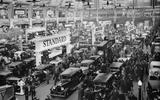Last year was another of global strife and uncertainty. Eighty-eight years ago, the story was much the same, as Britain struggled to drag itself out of the Great Depression and societal attitudes were rapidly changing in the wake of that and the Great War.
At least 1933 was “from the very outset interesting for motorists”, as we said in our 1934 retrospective.
The big news in January was a Hillman Wizard towing a caravan all the way to the Cairo motor show. In March, the SMMT revealed there had been “a satisfactory turn in the tide” in 1932 as more than 13,000 cars were registered for the first time; and Sir Malcolm Campbell once again broke the land speed record in Blue Bird.
Subscribe to the Autocar Archive today
In April, the car world mourned Sir Henry Royce, and then in May young Sir Tim Birkin was fatally injured in the Tripoli Grand Prix.
August was better, as Germany announced “that a great network of big motor roads was to be built exclusively for motor traffic” and in-car radio took a big step forward.
In October, the Olympia show was “a great success”, attracting almost 250,000; but there was another marked rise in traffic fatalities, “causing anxiety” and being addressed in a White Paper.
“Very satisfactory” car exports up to November (30,277, 29% up on 1932) and “the first steps to do away with the big mileage of tramways in London” ended the year, but there was gloom too as parliament looked to further restrict drivers.
Mercedes-Benz reveals innovative compact car

Mercedes-Benz revealed the 130H, a small car with a partly streamlined steel body, a backbone-type chassis, independent suspension all round, a 26bhp 1.3-litre four-cylinder engine and a three-speed manual gearbox dividing the rear axle. The ride proved fantastic but the handling very awkward, and poor sales meant it lasted only two years.
Two second-hand steals

Bangernomics was in action as we dug up two used bargains. First, a 1928 Chrysler Roadster with 44,355 miles for £55 (£3930 today). “In none of the essentials was it lacking” and “there was very considerable power”, at 25bhp. Second, a 1931 Austin Seven with Swallow saloon coachwork for £85 (£6070), “in particularly good state” and with good performance up to 40mph.
Intense grand prix drama and British success stories

1933 had been “a most interesting year” in motorsport, too. It started well as the new MG K3 won its class on debut at the Mille Miglia. Then we enjoyed “one of the hardest races there has ever been”, the “intensely dramatic” Monaco Grand Prix, as Achille Varzi and Tazio Nuvolari scrapped for victory.
Alfa Romeo won the Targa Florio and the Le Mans 24 Hours and MG found more success in the Tourist Trophy, but we were saddened by carnage in the Indianapolis 500 and Italian Grand Prix. Brooklands and Shelsley Walsh had continued to prosper, while the “very interesting” Donington Park found its feet.
Plus, we looked forward to the new Auto Union and Mercedes monsters that would dominate grands prix until the outbreak of World War Two.
The Autocar Archive, dating from 1895 to the modern day, is now available online. Subscribe today











Add your comment